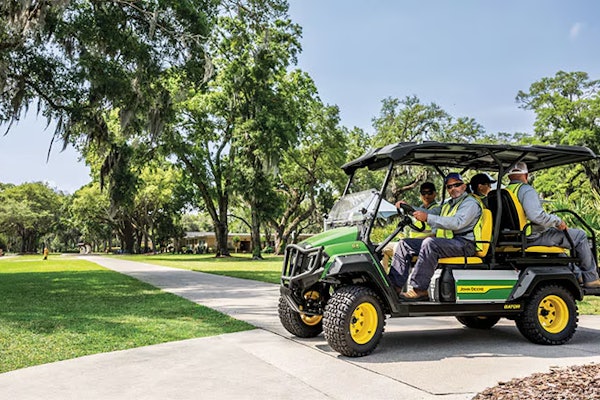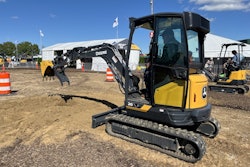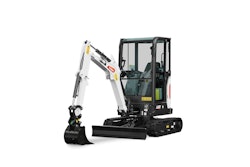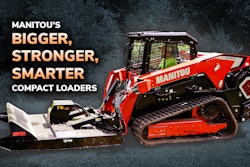Traditionally joined at the hip with horizontal directional drills, vacuum systems enjoyed 2004’s stellar year of HDD sales.
“We really don’t see that slowing down,” says Ed Savage, market segment manager for Vermeer. “A lot of it’s going to fiber-to-the-home work. But other markets – water and sewer and general utility are also active this year.”
When the HDD market took a dip in 2000 through late 2003, it gave vacuum systems a chance to shine on their own, says Kevin Smith, product manager for underground technology, Ditch Witch. “A lot of these units found alternative markets they could work in during that time,” Smith says. “And although a big percentage of them go along with horizontal directional drills, there’s a large number that stand alone and do other jobs.”
One of those alternative markets is soft excavation, most often done in areas congested with existing utility lines. If you are setting a vault, for example, you could use a vac system to excavate around existing lines rather than digging mechanically and possibly damaging something, Smith says.
Other vacuum applications include exposing existing utilities, installing road signs and utility poles, concrete dust cleanup and cleaning out valve boxes and manholes. Basically, people are using vacs anywhere they need to remove material and want to avoid hand digging.
After the telecom high
If you haven’t purchased a vac system since the telecom bust in 2000, the units have several new features you might not know about.
An onboard hydraulic circuit allows for the use of hydraulic tools such as tampers and breakers. Manufacturers have added sewer-jetting and culvert-cleaning options, and a hose boom keeps the hose off the operator’s shoulder for better productivity. An idle-down feature can cut engine power when the trigger is released on the digging tool, keeping the operator from having to return to the control console to adjust engine speed when excavation is completed. A hot box option allows you to dig in frost and heat water for sewer jetting. Pressurized offload is an option that unloads the spoils tank quicker than the traditional method of simply opening the gate and letting gravity dump the spoils. Most manufacturers have reduced the noise levels of their vacs in response to requests from customers working in cities. They’ve also refined the various excavation tools that come with the systems.
TIP: Tilt the hose end at an angle so it can suck in air as well as spoils. If you place the end of the hose flat against the ground, you’ll cut off the vacuum suction.
Buying decisions
There are two different types of vacuum excavation systems: hydro and pneumatic. Hydro units cut soil using high-pressure water, and pneumatic vacs use high-pressure air. Hydro vacs work faster and in a wider variety of soil conditions, but the spoil is unusable for backfill because of its high moisture content, says Bill Gilman, director of marketing for McLaughlin Boring Systems. Pneumatic vacs are slower in most cases and should be used only in porous soils such as sand or loam. These systems cost more because they require at minimum a 185-cfm air compressor and a sophisticated filtration system, but the dry soil they retrieve can be used immediately to backfill the excavation.
After taking soil type into consideration, deciding what type of vac you need depends on what you want to do with the spoils. If you aren’t concerned about reusing the soil on the jobsite, if you have the capability to move it off the jobsite or if you need to bring in backfill regardless, a hydro system often will be more efficient for you because it will work faster in most soils, Smith says. (For more information about the pros and cons of hydro and pneumatic vac systems, see the chart on page 80.)
Other factors to consider are spoils tank size, amount of vacuum force and lift capacity.
Vac systems can be truck units, trailer mounted or skid mounted to fit into an existing fleet truck. Municipalities typically own truck vacs. Trailer- and skid-mounted units come with spoils tanks ranging between 100 gallons and 1,400 gallons in capacity. If your jobs involve small excavation holes for applications such as fiber-to-the-home work, a tank with a 500-gallon capacity or less would be sufficient. “It’s a lot easier to get around town and it’s a lot easier to deal with on the jobsite,” Savage says. If you are doing bigger jobs in rural areas, however, you’ll want to spend less time transporting spoils to the dump site, so a larger tank would make more sense.
As far as the amount of vacuum produced – measured in cubic feet per minute – trailer-mounted units commonly offer two options. One is in the 500-cfm range and the other is in the 900- to 1,000-cfm span. “If you’re a contractor who’s looking for high production, then you need the high cfm to increase your digging capabilities,” Smith says. “It’s not that the smaller one wouldn’t dig the same depth, but it may take you twice as long to get there.”
The high-cfm option adds several thousand dollars to the cost of the vacuum system because it requires more horsepower, and therefore a larger engine, Savage says.
Lift capacity for vacuum systems usually ranges from 15 to 28 inches of mercury. For every inch of mercury, you can lift a solid column of water approximately 14 inches vertically, Smith says. With no air being introduced, a vac with a lift of 15 inches of mercury will excavate to a depth of 12 to 15 feet. If you are introducing air to soil and water, it will go deeper.
TIP: Vacs excel at soft excavation, allowing you to dig without damaging existing infrastructure.
Tips for efficient operation
As with most equipment, proper operation can be as important as having the right machine for your applications. “We have found that after the first week with a system, most of the problems disappear as the operator gets through the learning curve and feels comfortable with the unit,” Gilman says.
One common mistake is not tipping the hose end at an angle so that it can suck in air. “When you’re vacuuming, it’s just like your shop vac in the garage – you don’t want to have the end of the hose flat against the ground or the concrete where it cuts off the vacuum,” Savage says. “It quits sucking up product.”
When exposing utilities, use the potholing tool. “It’s a one-man system,” Savage says. “Sometimes you’ll see two guys out there – one of them will have the wash wand and another guy will be holding the vac hose, sucking up the spoil,” Savage says. But the potholing tool, or emulsifier gun, combines those operations into one.
Smith says one of the most misunderstood things about vacuum excavation is the density of different soil types. “If you don’t understand this, you may be overloading your towing vehicle and/or your trailer,” he says. Smith recommends running the full unit across a set of scales a few times if you’re new to using vacuum systems.
If the machine fails to pull a vacuum, one of the ports to the tank or the gate valve has probably been left in a semi-open position, Gilman says. And if the rear door is leaking, it is most likely the result of damage to the door seal caused by cleaning with the water lance.
Filter maintenance a big issue
Not doing general maintenance can also cause a vacuum system to operate improperly. Savage recommends cleaning the inside of the spoils tank at the end of each day. “Drilling mud clogs up,” he says. “After awhile, it’ll end up setting up like concrete in the tank.”
Having a clean air filter is extremely important to keeping the vac system performing as it should. “That’s the life of the unit,” Smith says. “If you don’t maintain your filter – that’s what filters the dirt out of the air that’s moving through the vacuum pump – it will dramatically shorten the life of the unit.”
How often you should check and change the filter depends on the jobsite environment. If you have a dry, dusty application, you need to check multiple times during the day, but if you’re working in a wet environment, you might be able to go a full day without maintaining the filter. “That’s why it’s important to understand the soil you’re in and how it’s affecting your unit’s performance,” Smith says.









